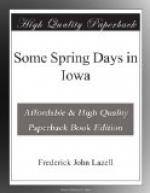April
stood with tearful face
With violets in her hands,
and in her hair
Pale wild anemones; the fragrant
lace
Half-parted from her breast,
which seemed like fair,
Dawn-tinted mountain snow,
smooth-drifted there.
In this long list of April flowers—some observers will be able to make it still longer—there are many favorites. The pretty rue-anemone recalls the tradition that Anemos, the wind, chose the delicate little flowers of this family as the heralds of his coming in early spring. And in the legend of Venus and Adonis the anemone is the flower that sprang from the tears of the queen as she mourned the death of her loved one. Theocritus put the wind-flowers into his Idylls, and Pliny said that only the wind could open them. The Spring beauty has as rich a legend, for it was the Indian Miskodeed, left behind when Peboan, the winter, the Mighty One, was melted by the breath of spring. The toothwort (dentaria laciniata) is sometimes known as the pepper-root, and every school boy and girl living near the woods is familiar with the taste of its tubers and the appearance of its cross-shaped flowers. The plumy dicentra, or Dutchman’s breeches, seems so feminine as to be grossly misnamed until we remember that it was first discovered in the Rip Van Winkle country. The wild ginger with its two large leaves and its queer little blossoms close to the ground is another delight to the saunterer along the rocky slopes, where the feathery shad-bush—the aronia of Whittier—with its wealth of snowy blossoms and the wild plum not far away, with its masses of pure white, are inspirations to clean and sweet lives, calling to mind the lines of Wordsworth:
One impulse from a vernal wood
May teach you
more of man,
Of moral evil and of good
Than all the sages
can.
In rocky fields and hillsides and dry open woods, the dwarf everlasting (Antennaria plantaginifolia) with its silvery-white little florets set in delicate cups, is one of the first species of the great composite family to bloom. We take it from between the rocks and think of those lines of Tennyson, which John Fiske declared to be among the deepest thoughts ever uttered by poet:
Flower in the crannied wall
I pluck you out of the crannies,
I hold you here, root and
all in my hand
Little flower,—but
if I could understand
What you are, root and all,
and all in all,
I should know what God and
man is.
Even more innocent, fresh and fair, is the bloodroot, with its snowy petals, golden center and ensanguined root-stock which crimsons the fingers that touch it. This is the herb, so the legend says, which the Israelites in Egypt dipped in sacrificial blood to mark their doorposts. As long ago as last November we dug up one of the papery sheaths and found the flower, then about a half inch long, snugly wrapped in its single leaf; and now the pale green leaf has pushed up and unfolded, showing the fragile flower in all its beauty.




